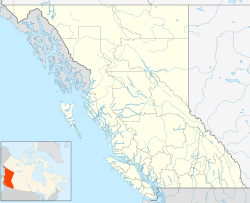Zeballos, British Columbia
| Zeballos | |
|---|---|
| Village | |
| The Corporation of the Village of Zeballos | |
| Location of Zeballos in British Columbia | |
| Coordinates: 49°59′4″N 126°51′14″W / 49.98444°N 126.85389°W | |
| Country |
|
| Province |
|
| Region | Vancouver Island |
| Regional district | Strathcona |
| Founded | 1930s |
| Incorporated | 1952 |
| Government | |
| • Governing body | Zeballos Village Council |
| • Mayor | Donn Cox |
| Area | |
| • Total | 1.45 km2 (0.56 sq mi) |
| Population (2011) | |
| • Total | 125 |
| Time zone | PST (UTC-8) |
| Waterways | Esperanza Inlet |
| Climate | Cfb |
| Website | Village of Zeballos |
Zeballos (pop. 125) is a village located on the northwest coast of Vancouver Island in British Columbia, Canada. While legend suggests Spanish gold seekers may have explored the area in the late 16th century, Zeballos is now known for its ecotourism and sport fishing.
Zeballos is a deep-sea port surrounded by rugged mountains and forests, located on the Zeballos River delta, at the end of Zeballos Inlet. It is accessible from Highway 19, about a two and half hour drive north of Campbell River. Zeballos' position relative to nearby Nootka Sound and Kyuquot Sound make it a popular "jump-off" point for tourists and anglers. Other areas of interest include Nootka Island, Fair Harbour, a 35 km (22 mi) trip by unpaved road from Zeballos, and Brooks Peninsula Provincial Park.
The eponymous inlet was named for Lt. Ciriaco Ceballos, a crew member aboard an early ship of Spanish explorer Alessandro Malaspina's expedition (1789-1794), the location of Zeballos remained relatively obscure until over 120 years later, when a mining camp by that name emerged due to a gold rush in the 1930s. The name became official as that of the local post office in 1946 and was incorporated as a village municipality in 1952. Although estimates vary, Zeballos may have had a population of over 5,000 during the peak of mining activity. Between 1938 and 1943, $13 million worth of gold bricks were shipped from Zeballos.
...
Wikipedia

